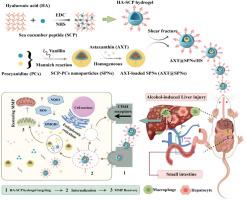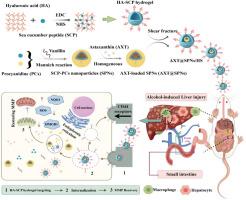Preparation of procyanidins-SCP nanoparticles doped in hyaluronic acid-SCP hydrogel with intestinal sustained release to enhance the bioavailability of astaxanthin
IF 9.8
1区 农林科学
Q1 CHEMISTRY, APPLIED
引用次数: 0
Abstract
Sea cucumber peptide (SCP) reacted with procyanidins and vanillin to form a food-grade nanoparticles (SPNs) via the Mannich reaction. After encapsulation astaxanthin (AXT), the SPNs was attached to a SCP-modified hyaluronic acid (HA) hydrogel to construct AXT@SPNs/HS. The AXT@SPNs/HS exhibited an average size of approximately 1281 nm, while the AXT@SPNs had an average size of 510 nm. The loading capacity of AXT in AXT@SPNs and AXT@SPNs/HS were 6.81 ± 0.10 and 6.56 ± 0.19 μg/mg, respectively. Sustained release of AXT was found during AXT@SPNs/HS digestion and HA-SCP hydrogel provided a significant advantage in protecting AXT in acidic conditions. AXT@SPNs/HS could effectively target RAW264.7 macrophages and mitigated oxidative stress inflammatory response caused by alcohol. AXT@SPNs/HS alleviated acute alcoholic liver damage in mice model. The results illustrated AXT@SPNs/HS might become a candidate with intestinal sustained release to enhance its bioavailability.


原花青素- scp纳米颗粒掺入透明质酸- scp水凝胶肠道缓释的制备提高虾青素的生物利用度
海参肽(SCP)与原花青素和香兰素通过曼尼希反应形成食品级纳米颗粒(SPNs)。将虾青素(AXT)包封后,将SPNs附着在scp修饰的透明质酸(HA)水凝胶上构建AXT@SPNs/HS。AXT@SPNs/HS的平均尺寸约为1281 nm,而AXT@SPNs的平均尺寸为510 nm。在AXT@SPNs和AXT@SPNs/HS中,AXT的加载量分别为6.81 ± 0.10和6.56 ± 0.19 μg/mg。在AXT@SPNs/HS消化过程中发现AXT的缓释,HA-SCP水凝胶在酸性条件下保护AXT具有显著优势。AXT@SPNs/HS能有效靶向RAW264.7巨噬细胞,减轻酒精引起的氧化应激炎症反应。AXT@SPNs/HS减轻急性酒精性肝损伤小鼠模型。结果表明AXT@SPNs/HS可能成为肠道缓释的候选药物,以提高其生物利用度。
本文章由计算机程序翻译,如有差异,请以英文原文为准。
求助全文
约1分钟内获得全文
求助全文
来源期刊

Food Chemistry
工程技术-食品科技
CiteScore
16.30
自引率
10.20%
发文量
3130
审稿时长
122 days
期刊介绍:
Food Chemistry publishes original research papers dealing with the advancement of the chemistry and biochemistry of foods or the analytical methods/ approach used. All papers should focus on the novelty of the research carried out.
 求助内容:
求助内容: 应助结果提醒方式:
应助结果提醒方式:


